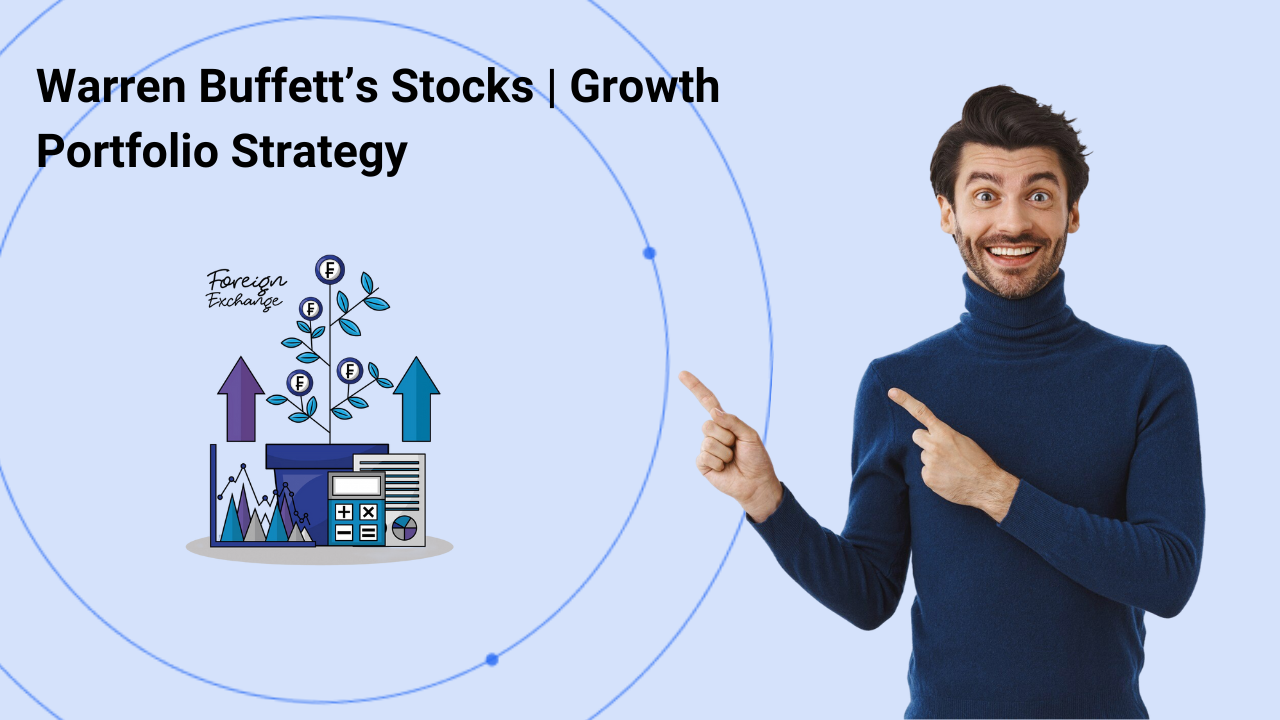Warren Buffett, often referred to as one of the greatest investors of all time, has built his fortune by adhering to simple yet powerful investment principles. His approach to stock selection, centred around long-term value and growth, offers valuable lessons for building a growth-oriented portfolio.
By focusing on companies with strong fundamentals, competitive advantages, and solid growth potential, Buffett’s strategy has consistently delivered impressive returns. In this blog, we will explore how Buffett’s stock picks can inspire the construction of a growth-focused portfolio and what modern investors can learn from his time-tested approach.
What Common Traits Do Warren Buffett’s Top Stock Picks Share That Align with Long-Term Growth Investing?
Warren Buffett’s investment strategy is grounded in finding high-quality companies that provide long-term value and growth. The top stocks in Buffett’s portfolio share several common traits that align with his philosophy of long-term growth investing:
- Strong Business Fundamentals:
Buffett places great emphasis on investing in companies with solid financials. This includes steady revenue growth, robust profitability, and manageable debt. Stocks like Coca-Cola and American Express in Buffett’s portfolio exemplify companies with reliable earnings and a strong financial foundation. - Competitive Moats:
Buffett often seeks companies with a competitive moat—a durable advantage that protects the business from competitors. This could be in the form of strong brand loyalty, patents, economies of scale, or unique products. Companies like Apple have a strong brand moat that makes it difficult for competitors to erode their market share. - High-Quality Management:
Buffett values companies that are led by capable and trustworthy management. He often invests in businesses where leadership has a proven track record of making sound business decisions and effectively steering the company toward growth. Berkshire Hathaway’s management team is a prime example of high-quality leadership that drives consistent growth. - Consistent Earnings Growth:
A key indicator of a successful growth stock is its ability to grow earnings consistently over time. Buffett looks for companies that can generate stable and predictable profits, even in challenging market conditions. Stocks like Wells Fargo and Johnson & Johnson have exhibited consistent earnings growth, making them solid choices for a long-term growth portfolio. - Undervalued with Room for Growth:
Buffett famously invests in companies that are undervalued relative to their intrinsic value. This allows him to buy high-quality businesses at a lower price, creating long-term growth opportunities as the market recognises their full potential. His investment in Geico and Precision Castparts are examples where he identified companies with strong growth potential at an attractive price.
These traits collectively form the backbone of Buffett’s investment philosophy, making them essential for anyone looking to build a growth-oriented portfolio.
Can Value Investing Principles Used by Buffett Be Applied to Build a Growth-Oriented Portfolio Today?
Warren Buffett is widely known for his value investing strategy, which focuses on purchasing undervalued stocks with strong growth potential. Despite the evolution of markets, his core principles remain highly relevant today for building a growth-oriented portfolio. Here’s how:
- Focus on Fundamentals:
At the heart of Buffett’s strategy is the analysis of a company’s fundamental value. By focusing on strong business fundamentals—such as consistent revenue growth, profitability, and efficient capital allocation—investors can identify companies that are poised for long-term growth. This approach can be applied today by analysing companies that are undervalued based on their strong fundamentals but still have growth potential. - Long-Term Perspective:
Buffett’s belief in holding investments for the long term aligns with the modern approach to growth investing. While short-term market movements can cause volatility, a focus on businesses with strong potential and a track record of growth allows investors to benefit from the compounding of earnings over time. Today’s investors can apply this principle by focusing on stocks that have solid growth drivers and can weather short-term market fluctuations. - Quality Over Quantity:
Buffett avoids buying into businesses that are overhyped or speculative. He focuses on quality companies with clear business models, strong management, and predictable growth. This approach is critical in today’s market, where many growth stocks might be overvalued due to short-term investor enthusiasm. By prioritising quality companies with solid fundamentals, investors can avoid the risk of investing in bubble stocks and focus on long-term growth. - Margin of Safety:
One of the cornerstones of Buffett’s approach is buying stocks at a discount to their intrinsic value, providing a margin of safety. This principle can be applied in today’s market by identifying undervalued stocks that show promise for future growth. While growth stocks often carry a higher valuation, focusing on companies with room to grow can help investors build a portfolio that balances risk and reward. - Adaptation to Modern Markets:
While Buffett’s early investments were focused on industries like insurance and consumer goods, today’s markets offer growth opportunities in technology, fintech, and renewable energy. By applying Buffett’s principles to modern sectors, investors can still find undervalued, high-quality companies with strong growth potential. For instance, companies involved in artificial intelligence or green technology may present opportunities similar to Buffett’s traditional picks.
Buffett’s value investing principles provide a framework that can be applied to modern growth-oriented portfolios. By focusing on businesses with strong fundamentals, a long-term perspective, and room for growth, investors can build a portfolio that is well-positioned for sustainable returns.
Which of Warren Buffett’s Current Holdings Are Still Delivering Strong Growth?
Warren Buffett’s portfolio includes a variety of companies that have demonstrated strong growth over the years. Some of his key holdings continue to provide impressive returns, showcasing the power of his investment strategy. Here are a few of Buffett’s current holdings that are still delivering strong growth:
- Apple Inc. (AAPL):
Apple remains one of the cornerstone stocks in Berkshire Hathaway’s portfolio. The tech giant has consistently delivered strong earnings growth, driven by its loyal customer base, premium pricing, and continuous innovation in hardware and software. The company’s services segment, including the App Store, iCloud, and Apple Music, has become a major contributor to its revenue growth, providing high-margin recurring income. Apple’s consistent growth and ability to adapt to changing consumer demands make it one of Buffett’s best-performing investments. - Coca-Cola (KO):
While Coca-Cola may not be a high-growth stock in the traditional sense, it remains a staple in Buffett’s portfolio due to its consistent earnings and strong global brand. The company has maintained steady growth over the years, driven by pricing power, a broad distribution network, and its dominance in the beverage sector. Coca-Cola’s focus on expanding its product portfolio into healthier options and maintaining strong cash flows makes it a reliable performer in Buffett’s portfolio. - American Express (AXP):
Another long-term holding, American Express, has grown significantly over the years. Its focus on the high-end consumer market, coupled with its global brand recognition and financial services innovation, has provided solid returns. Despite facing competition from other credit card companies, American Express maintains a loyal customer base and continues to benefit from consumer spending growth. Its strong cash flow generation and profitability have made it a consistent performer in Buffett’s portfolio. - Berkshire Hathaway (BRK.A & BRK.B):
Of course, Berkshire Hathaway itself, under Buffett’s leadership, has delivered strong growth through strategic acquisitions and investments in a wide range of sectors, including insurance, utilities, and manufacturing. Buffett’s ability to allocate capital effectively has allowed Berkshire Hathaway to outperform the broader market, creating significant value for its shareholders over time. - Moody’s (MCO):
Moody’s is a leader in credit ratings, research, and financial analytics. The company has shown consistent growth, benefiting from its dominant position in the credit ratings industry and the increasing demand for financial analytics in global markets. Despite market fluctuations, Moody’s continues to generate high margins and solid cash flow, making it a valuable growth asset in Buffett’s portfolio.
These holdings illustrate Buffett’s philosophy of investing in companies with strong brand value, consistent earnings growth, and pricing power. Each of these businesses continues to thrive due to their established competitive advantages and solid management, making them enduring performers in his portfolio.
How Does Buffett’s Approach to Quality and Business Fundamentals Translate to Modern Portfolio Building?
Warren Buffett’s approach to stock selection is centred around identifying companies with strong fundamentals and long-term viability. This approach remains incredibly relevant today, especially when building a growth-oriented portfolio. Here’s how Buffett’s emphasis on quality and business fundamentals can be applied to modern portfolio building:
- Focus on Companies with Durable Competitive Advantages:
One of Buffett’s key principles is investing in companies with a competitive moat—a unique advantage that protects them from competition. In today’s market, this could be brand strength, intellectual property, network effects (as seen in tech platforms), or economies of scale. Modern investors can apply this principle by looking for companies with strong, sustainable advantages that will allow them to thrive over time, especially in industries like technology, healthcare, and consumer goods. - High-Quality Management:
Buffett has always placed great value on businesses with competent and trustworthy management teams. Today, investors should assess the quality of leadership, focusing on the management’s ability to execute long-term strategies, adapt to market changes, and prioritise shareholder value. Companies with experienced, transparent leadership are more likely to weather economic downturns and capitalise on growth opportunities. - Consistent Cash Flow and Profitability:
Buffett prioritises businesses that generate consistent cash flow and have a history of profitability. In today’s market, investors should seek companies with predictable and reliable earnings, as these companies are more likely to provide steady growth and stability. Consistent cash flow also allows companies to reinvest in expansion, pay dividends, or reduce debt—factors that contribute to long-term value creation. - Undervalued but Strong Growth Potential:
Buffett has mastered the art of buying companies that are undervalued relative to their intrinsic value. Modern investors can replicate this approach by focusing on companies that are trading below their potential market value but have strong growth drivers. Look for businesses in sectors with high growth potential, such as renewable energy, artificial intelligence, or fintech, that offer room for significant capital appreciation. - Long-Term Focus:
Buffett is a staunch believer in holding investments for the long term, allowing the power of compounding to maximise returns. This long-term mindset remains relevant today as investors are encouraged to ignore short-term market fluctuations and focus on companies that will continue to grow and generate returns over decades. Adopting this philosophy in modern portfolio building ensures that investments are selected for their potential to create sustainable value rather than quick, short-term gains.
What Are Some Indian Companies That Reflect Buffett-Style Growth Potential?
Indian companies with Buffett-style growth potential include:
- HDFC Bank: Leading India’s banking sector with strong growth, a loyal customer base, and management that’s focused on digital expansion.
- Bajaj Finance: A rapidly growing financial services company with a strong competitive moat, solid cash flow, and pricing power.
- Reliance Industries: A diversified conglomerate with a significant market presence in energy, telecom, and retail, offering long-term growth potential.
These companies reflect Buffett’s principles by focusing on growth, competitive advantages, and strong management.
Key Takeaways for Building a Growth-Oriented Portfolio
Warren Buffett’s strategy of investing in high-quality companies with strong fundamentals and long-term growth potential remains highly relevant today. By focusing on competitive advantages and consistent earnings, investors can build a growth-oriented portfolio that stands the test of time. Platforms like Streetgains offer research-driven insights to help investors apply these principles and select stocks that align with Buffett’s approach, ensuring informed, long-term investment decisions.
Disclaimer:
The content in this blog is intended for informational purposes only and does not constitute investment advice, stock recommendations, or trade calls by Streetgains. The securities and examples mentioned are purely for illustration and are not recommendatory.
Investments in the securities market are subject to market risks. Please read all related documents carefully before investing.
Lessons from Warren Buffett’s Growth-Oriented Portfolio FAQs:
Buffett’s top picks typically share traits such as strong business fundamentals, competitive moats, reliable cash flow, and high-quality management, all of which contribute to long-term growth and stability.
Yes, Buffett’s value investing principles—focusing on undervalued companies with strong growth potential—remain highly applicable today. By seeking stocks with solid fundamentals and growth drivers, investors can build a robust growth portfolio.
Companies like Apple, Coca-Cola, and American Express continue to deliver strong growth for Buffett’s portfolio, driven by their consistent earnings, market leadership, and ability to adapt to changing consumer demands.
Buffett’s emphasis on investing in high-quality businesses with competitive advantages and strong management is timeless. Modern investors can apply these principles to identify stocks with sustainable growth potential and solid financials.
Indian companies like HDFC Bank, Bajaj Finance, and Reliance Industries mirror Buffett’s approach with their strong market positions, consistent earnings growth, and long-term growth potential.
Buffett’s approach emphasises long-term holding, allowing investors to benefit from compounding and avoid the distractions of short-term market fluctuations. Patience is key to maximising growth over time.
Companies with consistent cash flow and pricing power are crucial in Buffett’s strategy. These businesses can maintain profitability and grow, even during challenging market conditions, making them ideal for long-term investing.
Yes, retail investors can replicate Buffett’s strategy by investing through SIPs or ETFs that focus on high-quality growth stocks with strong fundamentals, following Buffett’s principle of investing in businesses with solid long-term growth potential.
Streetgains provides research-backed insights to help investors identify stocks with strong fundamentals, competitive advantages, and growth potential, aligning with Buffett’s value-investing approach for long-term portfolio building.
FAQs:
-
1. How to earn money daily from trading?
Earning money daily from trading involves strategies like day trading, where traders capitalise on small price movements within the same day. Success requires real-time market analysis, quick decision-making, and risk management.
-
2. How to earn money from equity trading?
To earn money from equity trading, you need to buy stocks at a lower price and sell them at a higher price. Success depends on researching companies, analysing stock trends, and using technical or fundamental analysis.
-
3. How to earn money from share trading in India?
In India, share trading offers profit potential through buying and selling stocks on exchanges like the NSE and BSE. To maximise returns, traders should use market research, tools like technical analysis, and risk management strategies.
-
4. How to make money from share trading in India?
Making money from share trading involves selecting the right stocks, timing the market, and implementing trading strategies like swing trading or day trading while staying informed about market trends.
-
5. How to transfer money from a trading account to a bank account?
To transfer money from your trading account to your bank, log into your trading platform, navigate to the funds section, and initiate a withdrawal request. The money will typically be credited to your linked bank account in 1 to 3 days.
-
6. How to withdraw money from a trading account?
You can withdraw funds by logging into your trading account, selecting the withdrawal option, and selecting the amount to transfer to your bank account. Ensure your bank account is linked and follow any steps your broker requires.
Subscribe to our Credits-Based Research System:
Pay only for successful research calls!












